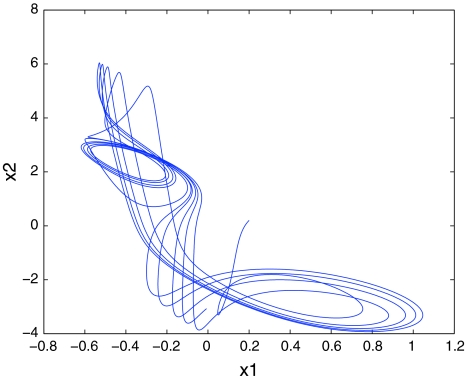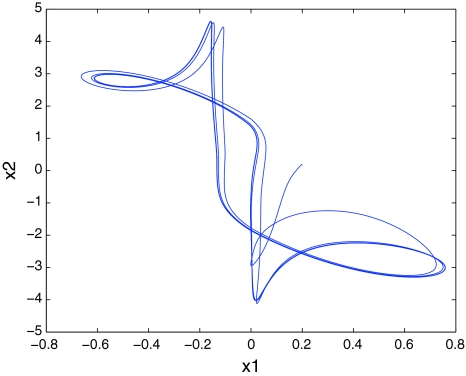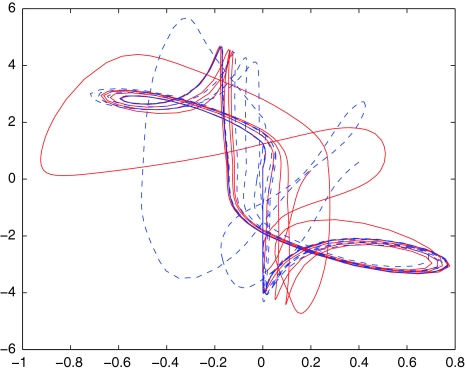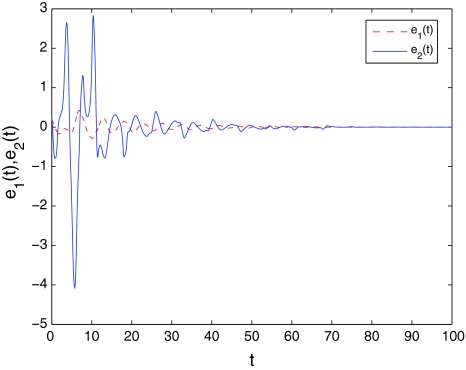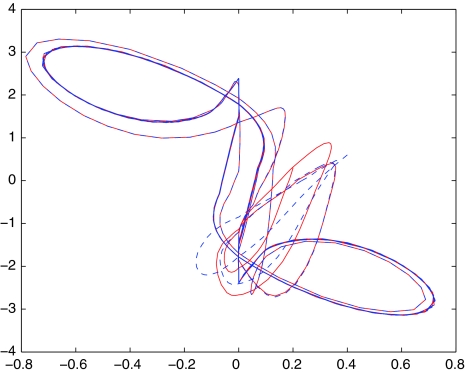Abstract
In this paper, local synchronization is considered for coupled delayed neural networks with discontinuous activation functions. Under the framework of Filippov solution and in the sense of generalized derivative, a novel sufficient condition is obtained to ensure the synchronization based on the Lyapunov exponent and the detailed analysis in Danca (Int J Bifurcat Chaos 12(8):1813–1826, 2002; Chaos Solitons Fractals 22:605–612, 2004). Simulation results are given to illustrate the theoretical results.
Keywords: Local synchronization, Delayed neural networks, Discontinuous activations, Filippov solutions, Lyapunov exponents
Introduction
It is well known that differential equations with discontinuous terms on the right-hand side occur in many real problems and are widely used as simplified mathematical models of physical systems although the classical solutions of such systems may not exist (Danca 2002). Sometimes physical laws are expressed by discontinuous functions, examples include dry friction, impacting machines, power circuits, switching in electronic circuits and many others (Danca 2004).
Delayed neural networks, as the special complex networks, have also been found to exhibit complex and unpredictable behaviors including stable equilibria, periodic oscillations, bifurcation and chaotic attractors (Cao 2001; Liang et al. 2008; Liu and Cao 2009). But all these papers are based on the assumption that the activation functions are continuous. In fact, the neural networks with discontinuous activation functions are more important, which frequently arise in practice (Forti and Nistri 2003; Forti et al. 2005). For the discontinuous system, it has been an old research topic for decades. Several types of solutions have been available such as Caratheodory solutions, Filippov solutions and sample-and-hold ones (Cortés 2008). Recently, the Filippov solutions have been utilized as a feasible approach in the field of mathematics and control for discontinuous dynamical systems (Cortés 2008; Filippov 1988; Forti and Nistri 2003; Forti et al. 2005; Huang et al. 2009; Liu and Cao 2009; Lu and Chen 2006, 2008).
On the other hand, synchronization means two or more systems which are either chaotic or periodic share a common dynamical behavior. It has been shown that this common behavior can be induced by coupling or by external forcing. As we all know, chaotic systems exhibit sensitive dependence on initial conditions. Because of this property, chaotic systems are difficult to be synchronized or controlled. Since the pioneer work of Pecora and Carrol (1990), chaotic synchronization has become a hot topic in nonlinear dynamics owing to their theoretical significance and potential applications.
For a dynamical system with discontinuous vector field, there have been a few works about the synchronization issue of discontinuous dynamical systems (Danca 2002, 2004). To the best of our knowledge, however, there are few works about the synchronization of discontinuous delayed neural networks. Motivated by the above discussions, in this paper we will consider the local synchronization of delayed neural networks with discontinuous activations based on Lyapunov exponents (Fujisaka and Yamada 1983). Firstly, under the framework of Filippov, the existence of solutions for such discontinuous neural systems can be guaranteed. Secondly, a sequence of smooth functional differential systems (approximation systems) are constructed and prove that the solutions of these systems converge to a solution of discontinuous system via the matrix measure. Finally, some sufficient criteria are derived to guarantee the local synchronization of the one-to-one coupled discontinuous neural networks by means of the Lyapunov exponents.
The rest of the paper is organized as follows. “Model formulation and preliminaries” gives some preliminaries. “Existence of Filippov solutions and approximation” discusses the existence of Filippov solutions for the discontinuous neural networks and constructs a sequence of smooth approximation systems. “Lyapunov exponents and local synchronization of coupled neural networks” presents some sufficient conditions for synchronization of the delayed coupled system. In “Illustrative examples”, simulation results aiming at substantiating the theoretical analysis are reported. Main conclusions are presented in “Conclusions”.
Model formulation and preliminaries
In this paper, we consider the following neural networks described by the system
 |
1 |
where  is the state vector associated with the neurons;
is the state vector associated with the neurons;  is an n × n constant diagonal matrix with di > 0, i = 1, 2, ... , n; A = (aij)n×n and B = (bij)n×n are the connection weight matrix and the delayed connection weight matrix, respectively;
is an n × n constant diagonal matrix with di > 0, i = 1, 2, ... , n; A = (aij)n×n and B = (bij)n×n are the connection weight matrix and the delayed connection weight matrix, respectively;  is a diagonal mapping where fi, i = 1, 2, ... , n, represents the neuron input-output activation; τ is a constant delay and I is a constant input.
is a diagonal mapping where fi, i = 1, 2, ... , n, represents the neuron input-output activation; τ is a constant delay and I is a constant input.
Definition 1 Class  of functions: we call
of functions: we call  if for all i = 1, 2, ..., n, fi(·) satisfies:
if for all i = 1, 2, ..., n, fi(·) satisfies:
fi(·) is continuously differentiable, except on a finite set of isolated points
 where the right and left limits
where the right and left limits  and
and  exist. Let Ik be open subsets of
exist. Let Ik be open subsets of  for k = 1, 2, ..., h such that
for k = 1, 2, ..., h such that 
- Except on the isolated points {ρik}, fi(·) is Lipschitz continuous, i.e., there exist constants K−i and K+i, i = 1, 2, ..., n, such that
Since the classical notion of derivatives at the discontinuity points of fi cannot be used here, a new concept of derivative is required.
2
Definition 2 Let  then f is said to be generalized differentiable at
then f is said to be generalized differentiable at  if the following limit exists and is finite
if the following limit exists and is finite
 |
3 |
and,  is called as the generalized derivative (generalized Jacobi matrix
is called as the generalized derivative (generalized Jacobi matrix  ) of f at x*. Further, we say that f is generalized differentiable on
) of f at x*. Further, we say that f is generalized differentiable on  if it is so at every
if it is so at every  and denoted this class of functions by
and denoted this class of functions by 
Example Let us consider
 |
with ρk = 0.  and
and  Then, for x* = 0, one has
Then, for x* = 0, one has  While for
While for
 |
 does not exist, and g(x) is not generalized differentiable at the point 0.In the following, we apply the framework of Filippov in discussing the solution of delayed neural networks (1).
does not exist, and g(x) is not generalized differentiable at the point 0.In the following, we apply the framework of Filippov in discussing the solution of delayed neural networks (1).
Definition 3 Suppose  Then
Then  is called as a set-valued map from
is called as a set-valued map from  if for each point x of a set
if for each point x of a set  there corresponds a nonempty set
there corresponds a nonempty set  A set-valued map F with nonempty values is said to be upper-semi-continuous at x0 ∈ E if, for any open set N containing F(x0), there exists a neighborhood M of x0 such that F(M) ⊂ N. F(x) is said to have a closed (convex, compact) image if for each x ∈ E, F(x) is closed (convex, compact).
A set-valued map F with nonempty values is said to be upper-semi-continuous at x0 ∈ E if, for any open set N containing F(x0), there exists a neighborhood M of x0 such that F(M) ⊂ N. F(x) is said to have a closed (convex, compact) image if for each x ∈ E, F(x) is closed (convex, compact).
Now we introduce the concept of Filippov solution. Consider the following system
 |
4 |
where f(·) is not continuous.
Definition 4 A set-valued map is defined as
 |
5 |
where K(E) is the closure of the convex hull of set  and μ(N) is Lebesgue measure of set N. A solution in the sense of Filippov (1988) of the Cauchy problem for Eq. 4 with initial condition x(0) = x0 is an absolutely continuous function x(t), t ∈ [0, T], which satisfies x(0) = x0 and differential inclusion:
and μ(N) is Lebesgue measure of set N. A solution in the sense of Filippov (1988) of the Cauchy problem for Eq. 4 with initial condition x(0) = x0 is an absolutely continuous function x(t), t ∈ [0, T], which satisfies x(0) = x0 and differential inclusion:
 |
6 |
Now we denote
 |
where  We extend the concept of the Filippov solution to the differential Eq. 1 as follows:
We extend the concept of the Filippov solution to the differential Eq. 1 as follows:
Definition 5 A function  is a solution (in the sense of Filippov) of the discontinuous system (1) on [−τ, T), if:
is a solution (in the sense of Filippov) of the discontinuous system (1) on [−τ, T), if:
x is continuous on [−τ, T) and absolutely continuous on [0,T);
- x(t) satisfies
Or equivalently,
7 - there exists a measurable function
 such that
such that  for a.e. t ∈ [−τ, T) and
for a.e. t ∈ [−τ, T) and
where the single-valued function α is the so-called measurable selection of the function
8  which approximates
which approximates  in some neighborhood of
in some neighborhood of 
It is obvious that the set-valued map  has nonempty compact convex values. Furthermore, it is upper-semi-continuous (Aubin and Cellina 1984) and hence it is measurable. Here, we remark that all the set-valued functions obtained by Filippov regularization applied to functions
has nonempty compact convex values. Furthermore, it is upper-semi-continuous (Aubin and Cellina 1984) and hence it is measurable. Here, we remark that all the set-valued functions obtained by Filippov regularization applied to functions  verify the above several properties. Hence, by the measurable selection theorem (Aubin and Frankowska 1990), if x(t) is a solution of (1), then there exists a measurable function
verify the above several properties. Hence, by the measurable selection theorem (Aubin and Frankowska 1990), if x(t) is a solution of (1), then there exists a measurable function  such that for a.e. t ∈ [0, +∞), the Eq. 8 is true.
such that for a.e. t ∈ [0, +∞), the Eq. 8 is true.
Definition 6 For any continuous function  and any measurable function
and any measurable function  such that
such that  for a.e. s ∈ [−τ, 0], an absolute continuous function x(t) = x(t, θ, ψ) associated with a measurable function α(t) is said to be a solution of the Cauchy problem for system (1) on [0,T) (T might be ∞) with initial value (θ(s), ψ(s)), s ∈ [−τ, 0], if
for a.e. s ∈ [−τ, 0], an absolute continuous function x(t) = x(t, θ, ψ) associated with a measurable function α(t) is said to be a solution of the Cauchy problem for system (1) on [0,T) (T might be ∞) with initial value (θ(s), ψ(s)), s ∈ [−τ, 0], if
 |
9 |
Definition 7 The matrix measure of a real square matrix A = (aij)n×n is as follows:
 |
where  is an induced matrix norm on
is an induced matrix norm on  is the identity matrix, and p = 1, 2, ∞.
is the identity matrix, and p = 1, 2, ∞.
When the matrix norm  we can obtain the matrix measure
we can obtain the matrix measure 
Existence of Filippov solutions and approximation
In this section, we will prove that under some conditions, systems (9) exist solutions globally in the sense of Filippov.
Theorem 1 Suppose that satisfies a growth condition (g.c.): there exist constantsK1, K2 ≥ 0 with
satisfies a growth condition (g.c.): there exist constantsK1, K2 ≥ 0 with
 |
10 |
Then, there exists at least one solution of system (1) in the sense of Eq. 9.
Proof Based on the detailed discussions in “Model formulation and preliminaries", the set-valued map  is upper-semi-continuous with nonempty compact convex values, the local existence of a solution x(t) of (9) can be guaranteed (Filippov 1988). In Forti et al. (2005), the solution’s local existence was considered by step-by-step construction.Denote
is upper-semi-continuous with nonempty compact convex values, the local existence of a solution x(t) of (9) can be guaranteed (Filippov 1988). In Forti et al. (2005), the solution’s local existence was considered by step-by-step construction.Denote  By (10), for a.e. t ∈ [0, +∞), one has
By (10), for a.e. t ∈ [0, +∞), one has
 |
11 |
where  It follows that
It follows that
 |
By the Gronwall inequality, one has
 |
Hence, since x(t) remains bounded for positive times, it is defined on [0, +∞).
Remark 1 In Forti et al. (2005), the global existence of Filippov solutions was obtained by the Lyapunov method. In Lu and Chen (2006, 2008), the authors got the same results by constructing high-gain systems. In Huang et al. (2009); Xue and Yu (2007), the existence of period solutions have been guaranteed for the discontinuous sysytems by the famous Dugundji and Granas Theorem.
Next, we will construct a sequence of functional differential systems (approximation systems) with continuously differentiable nonlinear functions and prove that the solutions of these systems converge to a solution of system (1).
Let  be the set of discontinuous points of fi(·). Pick a strictly decreasing sequence
be the set of discontinuous points of fi(·). Pick a strictly decreasing sequence  with
with  such that
such that  holds for any k1 ≠ k2 and
holds for any k1 ≠ k2 and  where
where  Define functions
Define functions  as follows:
as follows:
 |
where  is continuously differentiable satisfying
is continuously differentiable satisfying
 |
12 |
 |
13 |
For example, we can pick  where
where  and
and  have to be determined from the above two equations.
have to be determined from the above two equations.
Thus, we obtain the following smooth system:
 |
14 |
which will be proved as an approximation of the initial discontinuous system (1).
From the construction, the condition (10) and Definition 1, there exist constants  and
and  such that
such that
 |
15 |
and
 |
16 |
As pointed out in Hale (1977), for the smooth function gm with every fixed m, the system
 |
has a unique solution xm(t) on [0, +∞).
Following, we will point out that the solution sequence of system sequence (14) converges to the solution of original system (1). To prove our results, the following two lemmas are needed.
Lemma 1 (Huang et al. 2009). Suppose that functiony(t) is non-negative whent ∈ (t0, + ∞) and satisfies the following
 |
wherea, b, σ are positive constants, anda > b. Then we have the following inequality
 |
where andris the unique positive solution of
andris the unique positive solution of
 |
Here the upper-right Dini derivativeD+y(t) is defined as whereh→0+means thathapproaches 0 from the right-hand side.
whereh→0+means thathapproaches 0 from the right-hand side.
Lemma 2 (Lu and Chen 2006, 2008). The solution sequence of system sequence (14) will converge to the solution of original system (1), if the solutions
of system sequence (14) will converge to the solution of original system (1), if the solutions are uniformly bounded.
are uniformly bounded.
Theorem 2 The solution sequence of approximation system (14) converges to the solution of original system (1) if for the constantK1in the growth condition (g.c.), the following inequality holds:
of approximation system (14) converges to the solution of original system (1) if for the constantK1in the growth condition (g.c.), the following inequality holds:
 |
17 |
Proof From Lemma 2, we only need to prove the solutions  of system (14) are uniformly bounded. Consider the following positive radially unbounded Lyapunov-Krasovskii functional candidate for model (14) as
of system (14) are uniformly bounded. Consider the following positive radially unbounded Lyapunov-Krasovskii functional candidate for model (14) as
 |
18 |
Calculating the upper right-hand derivative of V(t) along the positive half trajectory of Eq. 14, we have
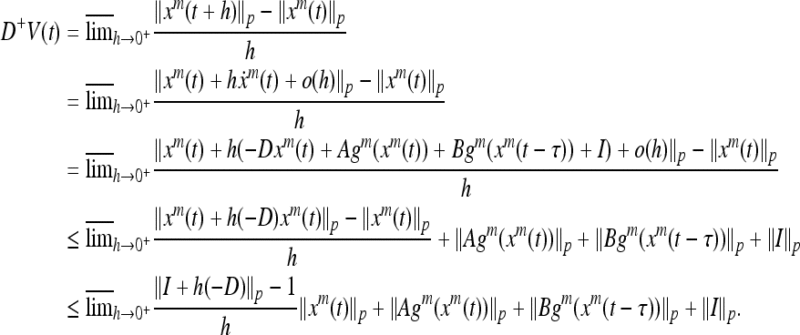 |
It follows from (15) that
 |
Let  By Lemma 1, it follows that
By Lemma 1, it follows that
 |
19 |
where r is the unique positive solution of
 |
Based on (19), it is obviously that the solutions {xm(t)} of the systems (14) will be located in one bounded set, this completes the proof.
Remark 2 In Lu and Chen (2006, 2008), the authors used the Arzela-Ascoli lemma and the diagonal selection principle to get the convergence of {xm(t)}, and then obtained the the convergence of  based on the Mazur’s convexity theorem. At last, they obtained the the convergence of measurable function sequence {γm(t)} and then got the existence of a solution for the discontinuous system finally. The key points lie in the uniform boundedness of solution sequence {xm(t)}, which could be ensured by Theorem 2 in this paper.
based on the Mazur’s convexity theorem. At last, they obtained the the convergence of measurable function sequence {γm(t)} and then got the existence of a solution for the discontinuous system finally. The key points lie in the uniform boundedness of solution sequence {xm(t)}, which could be ensured by Theorem 2 in this paper.
Remark 3 Matrix measure can have positive as well as negative values, whereas a norm can assume only nonnegative values. It is sign-sensitive in that μ(− A) ≠ μ(A) in general, whereas  Because of these special properties, the results based on matrix measure usually are more precise and less restrictive. In our paper, the uniform boundedness can be ensured by means of matrix measure which indicates that such approach is really effective.
Because of these special properties, the results based on matrix measure usually are more precise and less restrictive. In our paper, the uniform boundedness can be ensured by means of matrix measure which indicates that such approach is really effective.
Lyapunov exponents and local synchronization of coupled neural networks
For the the continuous dynamical system  based on the Oseledec’s theorem (Oseledec 1968), the Lyapunov exponents are
based on the Oseledec’s theorem (Oseledec 1968), the Lyapunov exponents are  σi are the eigenvalues of J, for x0 ranging over
σi are the eigenvalues of J, for x0 ranging over  where
where  can be replaced by
can be replaced by  to guarantee the existence of the Lyapunov exponents; J is the Jacobi matrix evaluated at the initial value x(t) satisfying variational equations
to guarantee the existence of the Lyapunov exponents; J is the Jacobi matrix evaluated at the initial value x(t) satisfying variational equations  and ɛ(t) is the distance function between the two trajectories starting from x0 and x0 + ɛ(0), respectively, with initial conditions ɛ(t0) = I generally.
and ɛ(t) is the distance function between the two trajectories starting from x0 and x0 + ɛ(0), respectively, with initial conditions ɛ(t0) = I generally.
Now, for the discontinuous system (1) with  the Jacobi matrix J(x) is not defined at
the Jacobi matrix J(x) is not defined at  but, by Definitions 1 and 2, the generalized Jacobi matrix
but, by Definitions 1 and 2, the generalized Jacobi matrix  can be used.
can be used.
In this section, we consider the synchronization issue of coupled delayed neural networks consisting of two identical networks:
 |
20 |
where c > 0 is the coupling strength.
Let G(x(t)) = −Dx(t) + Af(x(t)) + Bf(x(t − τ)) + I(t) with f is a continuous function, then the one-to-one coupled delayed neural networks (20) change to be
 |
21 |
The variational equations for the synchronized trajectory z(t) = x(t) − y(t) = 0 of (21) are:
 |
22 |
where J1(t) is the Jacobi matrix of G(t) evaluated along the synchronized trajectory x(t) = y(t).
Subtracting in (21) that
 |
23 |
where J2(t) is the Jacobi matrix of the flow z(t).
Based on the fundamental results of the linear stability. The spectrum of Lyapunov exponents of Eq. 23, given by the characteristic equation, can be divided into two parts: λ1 = {λ1, λ2, ..., λn} associated with the evolution on the invariant (synchronization) manifold x(t) = y(t), and the remaining part  describing the evolution transverse to the above manifold and exactly describing the distance between the state and the synchronization manifold x(t) = y(t). Let
describing the evolution transverse to the above manifold and exactly describing the distance between the state and the synchronization manifold x(t) = y(t). Let  denote the largest
denote the largest  in the transverse space, The negativity of
in the transverse space, The negativity of  guarantees that all the transverse eigenmodes are stable. In other words, the coupled system (20) is locally synchronized if
guarantees that all the transverse eigenmodes are stable. In other words, the coupled system (20) is locally synchronized if  From (23), we know that
From (23), we know that  So, if the largest Lyapunov exponent λm verifies c > λm/2, then local synchronization can be realized.
So, if the largest Lyapunov exponent λm verifies c > λm/2, then local synchronization can be realized.
Hence, for the continuous function f, the following Lemma can ensure the synchronization of one-to-one coupled neural networks:
Lemma 3 (Danca2002). Let λmbe the largest Lyapunov exponent of the continuous dynamical system Assume one-to-one coupling (20): Ifc > λm/2, then the coupled systems satisfy local synchronization.
Assume one-to-one coupling (20): Ifc > λm/2, then the coupled systems satisfy local synchronization.
When f is discontinuous but  the above Lemma can be utilized to realize the synchronization of one-to-one coupled discontinuous neural networks based on the generalized Jacobi matrix.
the above Lemma can be utilized to realize the synchronization of one-to-one coupled discontinuous neural networks based on the generalized Jacobi matrix.
Let  be the set of discontinuous points of fi(·). By Definitions 1 and 2, defining
be the set of discontinuous points of fi(·). By Definitions 1 and 2, defining
 |
and q(x) = (q1(x1), q2(x2), ..., qn(xn))T. From construction, we can see that q(x) is continuously differentiable on  and f’s generalized Jacobi matrix
and f’s generalized Jacobi matrix 
Hence, the Lyapunov exponents of the following smooth system:
 |
24 |
are just the ones of discontinuous neural network (1) in the sense of generalized derivative.
Theorem 3 Let λmbe the largest Lyapunov exponent of system (24). Assumec > λm/2 in the one-to-one coupling (20), then the coupled discontinuous systems (20) satisfy local synchronization.
Proof Straightforward from Lemma 3 and Definition 2.
Remark 4 When the discontinuous system possesses chaotic behavior, the  class function f could ensure that the chaotic behavior still remain chaotic when the trajectories cross the discontinuous surface. In addition, the concept of generalized derivative is introduced, which seems that it is possible to find the Lyapunov exponents and synchronize two identical discontinuous systems which having chaotic motion. Hence, the activation function f need to be of
class function f could ensure that the chaotic behavior still remain chaotic when the trajectories cross the discontinuous surface. In addition, the concept of generalized derivative is introduced, which seems that it is possible to find the Lyapunov exponents and synchronize two identical discontinuous systems which having chaotic motion. Hence, the activation function f need to be of  class in this paper.
class in this paper.
Illustrative examples
Example 1 Consider the coupled discontinuous delayed neural networks consisting of two identical networks (20) with
 |
where the activation function is defined as  ; x(t) = [x1(t), x2(t)]T, y(t) = [y1(t), y2(t)]T are the state vectors. When a = 0, the neural network model (1) is actually chaotic (Lu 2002) as shown in Fig. 1. When a ≠ 0, the model (1) is a discontinuous neural network. But for the activation function
; x(t) = [x1(t), x2(t)]T, y(t) = [y1(t), y2(t)]T are the state vectors. When a = 0, the neural network model (1) is actually chaotic (Lu 2002) as shown in Fig. 1. When a ≠ 0, the model (1) is a discontinuous neural network. But for the activation function  by utilizing the properties of generalized derivative and based on the detailed discussion in Danca (2002, 2004), the chaotic behavior could remain chaotic when the trajectories cross the discontinuous surface (due to the discontinuous points
by utilizing the properties of generalized derivative and based on the detailed discussion in Danca (2002, 2004), the chaotic behavior could remain chaotic when the trajectories cross the discontinuous surface (due to the discontinuous points  as shown in Fig. 2 with a = −0.025.
as shown in Fig. 2 with a = −0.025.
Fig. 1.
Phase trajectories of model (1) with a = 0
Fig. 2.
Phase trajectories of model (1) with a = −0.025
Using the one-to-one synchronization Theorem 3, we obtained the result illustrated in Figs. 3 and 4 with the initial condition x(t) = (0.2, 0.3)T, y(t) = (0.4, 0.6)T, ∀ t ∈ [ − 1, 0]. If we choose c = 0.2, after small time, the systems become synchronized.
Fig. 3.
Synchronization of two identical discontinuous networks modeled (20)
Fig. 4.
The synchronization error of the state variables ei = yi(t) − xi(t), i = 1, 2
Example 2 In Example 1, pick the connection weight matrix A and the delayed connection weight matrix B as  and
and  respectively. Let a = −0.03, utilizing the properties of generalized derivative and based on the detailed discussion in Danca (2002, 2004), the chaotic behavior (Lu 2002) could remain chaotic when the trajectories cross the discontinuous surface. Using the one-to-one synchronization Theorem 3 again, we obtained the result illustrated in Figs. 5 and 6 with the initial condition x(t) = (0.2, 0.3)T, y(t) = (0.4, 0.6)T, ∀ t ∈ [−1, 0]. If we choose c = 0.7, after small time, the systems become synchronized.
respectively. Let a = −0.03, utilizing the properties of generalized derivative and based on the detailed discussion in Danca (2002, 2004), the chaotic behavior (Lu 2002) could remain chaotic when the trajectories cross the discontinuous surface. Using the one-to-one synchronization Theorem 3 again, we obtained the result illustrated in Figs. 5 and 6 with the initial condition x(t) = (0.2, 0.3)T, y(t) = (0.4, 0.6)T, ∀ t ∈ [−1, 0]. If we choose c = 0.7, after small time, the systems become synchronized.
Fig. 5.
Synchronization of two identical discontinuous networks modeled (20)
Fig. 6.
The synchronization error of the state variables ei = yi(t) − xi(t), i = 1, 2
Conclusions
This paper has discussed the local synchronization of delayed neural networks with discontinuous activations. Sufficient conditions have been derived for local synchronization of such systems based on the Lyapunov exponents. In the sense of Filippov solution and generalized derivative, coupled chaotic synchronization of discontinuous delayed neural networks has been considered. The obtained results are novel since there are few works about the synchronization of delayed discontinuous systems. Finally, two numerical examples have been given to illustrate the usefulness of our results.
Acknowledgments
This work was jointly supported by the National Natural Science Foundation of China under Grants No. 60874088 and 11072059, the Specialized Research Fund for the Doctoral Program of Higher Education under Grant 20070286003, the JSPS Innovation Program CX09B_043Z and the Scientific Research Foundation of Graduate School of Southeast University YBJJ0909.
Contributor Information
Xiaoyang Liu, Email: liuxiaoyang1979@gmail.com.
Jinde Cao, Email: jdcao@seu.edu.cn.
References
- Aubin J, Cellina A. Differential inclusions. Berlin: Springer; 1984. [Google Scholar]
- Aubin J, Frankowska H. Set-valued analysis. Boston: Birkhauser; 1990. [Google Scholar]
- Cao J. A set of stability criteria for delayed cellular neural networks. IEEE Trans Circuits Syst I. 2001;48(4):494–498. doi: 10.1109/81.917987. [DOI] [Google Scholar]
- Cortés J. Discontinuous dynamical systems. IEEE Control Syst Mag. 2008;28(3):36–73. doi: 10.1109/MCS.2008.919306. [DOI] [Google Scholar]
- Danca M. Synchronization of switch dynamical systems. Int J Bifurcat Chaos. 2002;12(8):1813–1826. doi: 10.1142/S0218127402005522. [DOI] [Google Scholar]
- Danca M. Controlling chaos in discontinuous dynamical systems. Chaos Solitons Fractals. 2004;22:605–612. doi: 10.1016/j.chaos.2004.02.032. [DOI] [Google Scholar]
- Filippov A. Differential equations with discontinuous right-hand side, Mathematics and its Applications (Soviet Series) Boston: Kluwer; 1988. [Google Scholar]
- Forti M, Nistri P. Global convergence of neural networks with discontinuous neuron activations. IEEE Trans Circuits Syst I. 2003;50(11):1421–1435. doi: 10.1109/TCSI.2003.818614. [DOI] [Google Scholar]
- Forti M, Nistri P, Papini D. Global exponential stability and global convergence in finite time of delayed neural networks with infinite gain. IEEE Trans Neural Netw. 2005;16(6):1449–1463. doi: 10.1109/TNN.2005.852862. [DOI] [PubMed] [Google Scholar]
- Fujisaka H, Yamada T. Stability theory of synchronised motion in coupled oscillator systems. Prog Theor Phys. 1983;69:32–47. doi: 10.1143/PTP.69.32. [DOI] [Google Scholar]
- Hale J. Theory of functional differential equations. New York: Springer; 1977. [Google Scholar]
- Huang L, Wang J, Zhou X. Existence and global asymptotic stability of periodic solutions for Hopfield neural networks with discontinuous activations. Nonlinear Anal. 2009;10(3):1651–1661. doi: 10.1016/j.nonrwa.2008.02.022. [DOI] [Google Scholar]
- Huang T, Li C, Yu W, Chen G. Synchronization of delayed chaotic systems with parameter mismatches by using interittent linear sate feedback. Nonlinearity. 2009;22:569–584. doi: 10.1088/0951-7715/22/3/004. [DOI] [Google Scholar]
- Liang J, Wang Z, Liu Y, Liu X. Global synchronization control of general delayed discrete-time networks with stochastic coupling and disturbances. IEEE Trans Syst Man Cybern B. 2008;38(4):1073–1083. doi: 10.1109/TSMCB.2008.925724. [DOI] [PubMed] [Google Scholar]
- Liu X, Cao J. On periodic solutions of neural networks via differential inclusions. Neural Netw. 2009;22:329–334. doi: 10.1016/j.neunet.2008.11.003. [DOI] [PubMed] [Google Scholar]
- Lu H. Chaotic attractors in delayed neural networks. Phys Lett A. 2002;298:109–116. doi: 10.1016/S0375-9601(02)00538-8. [DOI] [Google Scholar]
- Lu W, Chen T. Dynamical behaviors of delayed neural networks systems with discontinuous activation functions. Neural Comput. 2006;18:683–708. doi: 10.1162/neco.2006.18.3.683. [DOI] [Google Scholar]
- Lu W, Chen T. Almost periodic dynamics of a class of delayed neural networks with discontinuous activations. Neural Comput. 2008;20:1065–1090. doi: 10.1162/neco.2008.10-06-364. [DOI] [PubMed] [Google Scholar]
- Oseledec V. A multiplicative ergodic theorem; Lyapunov characteristic numbers for dynamical systems. Trans Moscow Math Soc. 1968;19:197–231. [Google Scholar]
- Pecora L, Carroll T. Synchronization in chaotic systems. Phys Rev Lett. 1990;64:821–824. doi: 10.1103/PhysRevLett.64.821. [DOI] [PubMed] [Google Scholar]
- Xue X, Yu J. Periodic solutions for semi-linear evolution inclusions. J Math Anal Appl. 2007;331:1246–1262. doi: 10.1016/j.jmaa.2006.09.056. [DOI] [Google Scholar]



